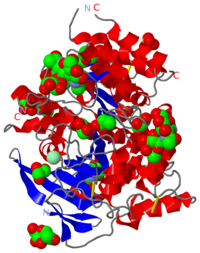Joel L. Sussman Sandbox 1
From Proteopedia
Butyrylcholinesterase, also known as pseudocholinesterase, BCHE or BuChE, is an enzyme that, in humans, is encoded by the BCHE gene. Butyrylcholinesterase is also called serum cholinesterase. It is very similar to the neuronal acetylcholinesterase, and is a non-specific cholinesterase found in the blood plasma, which hydrolyses many different choline esters. Butyrylcholine is a synthetic compound and does not occur in the body naturally. It is used as a tool to distinguish between acetyl- and butyrylcholinesterase. The structure for this protein is available in its unmodified form (2pm8 and 1p0i)
One of the main functions of butyrylcholinesterase is its ability to remove and clean away organophosphorus nerve agents. This function and its inhibitors has been intensibely studied by solving protein structure of BChE in combination with organophosphate inhibitors and substrate inhibitors.
Proteopedia examples on these experiments and related publications are
Contents |
Butyrylcholinesterase - BChE
hBChE - Apo human: 2pm8, 1p0i
BChE+organophosphate inhibitors causing irreversible inhibition
2wsl, 2wig – hBChE+TA4 2wil, 2wij - hBChE+TA5 2wid, 2wif - hBChE+TA1 2wik - hBChE+TA6 3djy, 3dkk - hBChE+tabun 1xlu - hBChE+DFP 1xlw - hBChE+echothiophate 1p0q - hBChE+soman
BChE+inhibitor binding at surface of the protein
2j4c – hBChE+ HgCl2

